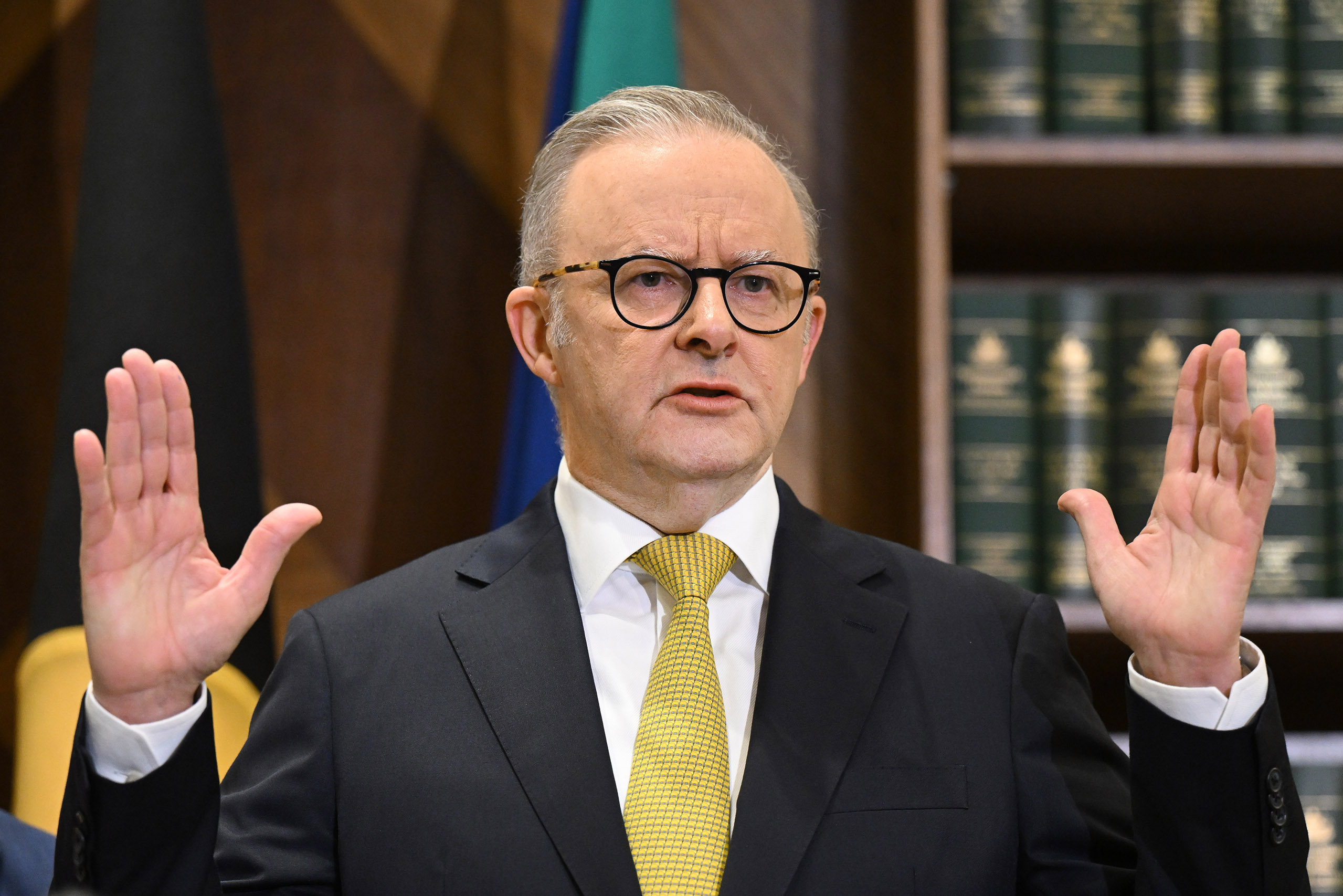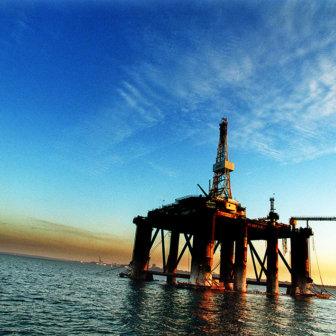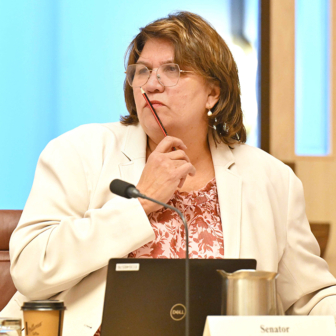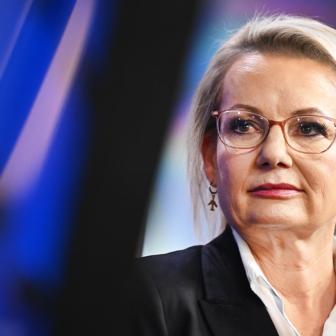If anyone doubted that Australia’s most important diplomatic relationship is now brutally transactional, Thursday’s mugged-by-reality announcement in Washington should relegate the idea to fantasy land.
In assessing the chances of president Donald Trump reversing or modifying the 10 per cent tariff he slapped on our exports to the United States — and judging what it might cost to amend it versus what it will cost if we can’t — it’s useful to understand how we got here. It’s a pretty crazy story.
Australia’s 2018 exemption from the first Trump administration’s tariffs on steel and aluminium took a full-court-press lobbying effort by Malcolm Turnbull and his ministers and their officials, backed by key US agencies enlisted to advocate for Australia. It involved an informal agreement — an understanding between friends — that Australia would keep steady its steel and aluminium exports to the United States.
We were a miniscule player, so it was an easy promise to make. But with no system to track export levels, it wasn’t so easy to keep. A 2019 surge in American demand for aluminium saw Australian companies lean in. Exports surged and, oops, the promise was broken.
Trump’s trade officials were furious. US trade representative Robert Lighthizer, trade adviser Peter Navarro and others urged their president to reverse Australia’s tariff exemption. Two things stopped them succeeding.
First, Trump liked Scott Morrison, who by this time was PM. Against both the odds and US expectations, the Liberal leader had won the mid-May 2019 election, and Trump likes winners.
He invited Morrison to make a state visit to Washington later that year and in the interim, when the two caught up at the G20 meeting in Osaka in late June, the president hosted the prime minister at a private congratulatory dinner. Lovely. Just twenty-four hours beforehand, though, Australian officials discovered Lighthizer was also attending. The government scrambled to get trade minister Simon Birmingham added to the guest list.
During the dinner, Lighthizer raised the aluminium transgression. When Birmingham responded, and the convivial atmosphere evaporated, Trump intervened, steering the conversation onto happier subjects. The dinner ended without further incident but it was clear Lighthizer was on the warpath.
Still, Trump’s liking for a winner wasn’t the only reason Lighthizer and Navarro and colleagues lost that 2019 fight. The other one came from left field. Two months before Morrison’s re-election, US special counsel Robert Mueller had concluded a two-year investigation into whether, ahead of the 2016 US presidential election, Trump’s Republican campaign team colluded with Russia to collect political dirt on his Democrat opponent Hillary Clinton.
Australia played a strangely central role in the controversy. As is now well documented, the investigation began after Australia’s high commissioner to London at the time, former foreign minister Alexander Downer, disclosed a conversation he’d had over drinks in May 2016 with a Trump campaign aide, George Papadopoulos. According to Downer, Papadopoulos remarked that Trump could win the 2016 election because his camp was receiving damaging information about Clinton from Russia — something Papadopoulos later said he couldn’t recall.
Downer, having duly reported the alleged comment in cables back to Canberra, didn’t take it seriously enough to advise Washington until July, when Wikileaks published documents from the Democratic National Committee. Downer’s information prompted the FBI special counterintelligence investigation that led to Mueller taking up the case in 2017. By then, Trump was president.
Mueller’s 2019 two-volume report found Russia had interfered in the election. He didn’t establish that Russia “conspired or coordinated” with the Trump campaign, although he noted contradictory testimonies, uncooperative witnesses and encrypted and deleted communications.
Trump commissioned attorney-general Bill Barr to prepare a response to Mueller’s findings. Barr wanted to include more evidence from Australia to support the argument that Papadopoulos’s alleged comments shouldn’t have been taken seriously. In the second half of 2019, Barr approached Australia’s ambassador to Washington, Joe Hockey, for help.
This is where the tariff threat comes in. In a deal not revealed publicly until now, Hockey provided Barr with a copy of an Australian diplomatic cable that contained language downplaying the significance of what was allegedly said. But he also insisted on a quid pro quo: that Australia not be punished for exceeding its steel and aluminium quotas.
It’s not clear which of these factors carried most sway: Trump’s disinclination to upset his new friend, the election-winning Morrison, whom he had by then hosted at the White House, or the Hockey–Barr contra deal. Maybe it was both. One way or another, the exemption stayed.
There were, however, conditions. The Morrison government prevailed on steel and aluminium producers to limit their exports. It also sent regular reports to Washington showing it wasn’t breaking the promise again.
After the Biden administration took office, the issue seems to have lost potency. When Russia invaded Ukraine and demand for Australian aluminium spiked, so did our exports. Suddenly, Australian had transgressed again.
Fast forward to 2025 and the problem for the current Australian government and the opposition is that Trump is back and his officials have long memories. Lighthizer’s stint ended with Trump’s first presidency, but Navarro is senior counsellor for trade and manufacturing under Trump II. He can now point to two examples of Australia breaking its promise.
A few things are different this time around.
For a start, nobody won exemptions. Trump opted to start negotiations with his foot on the throats of all key trading partners. Perhaps we can take heart from the fact that he almost apologised to the “wonderful people and wonderful everything” of Australia as he whacked the minimum 10 per cent extra on the cost of Australian products and named our ban on American bovines as his main, ahem, beef. In other words, it could have been worse.
Beyond that, numerous questions arise in the wake of the decision. Is it, in fact, negotiable? If so, how is that best approached? What do we need to put on the table? And in the domestic political context, who would that hurt most?
Australia’s leaders have little choice but to assume an affirmative answer to the first one. Otherwise, they do nothing — and that’s not tenable, certainly not weeks from a federal election.
But how to go about it? Well, Morrison is no help because he’s now a loser. And his Liberal successor and former cabinet colleague Peter Dutton can’t yet claim to be a winner, which complicates the politics of all this for him, on top of what seems to be a cooling of sentiment among Australian voters towards Trump and those espousing his ideas. Arguing that you’re not only best placed to build a relationship with the president but also best placed to stand up to him seems a little tricky.
But it’s not easy for Anthony Albanese either. He opted not to go and pay homage to the re-elected Trump on his way back from summits in South America late last year for fear of offending the incumbent Biden. So, while they’ve spoken on the phone, he’s never met him. But he did have dinner in Melbourne earlier this week with Trump’s Aussie golfing buddy Greg Norman, evidence that diplomacy continues to take many forms.
Aside from who to enlist, it’s what to offer that needs most urgent attention. Sentiment is no longer currency in this relationship. All those times shoulder-to-shoulder in the trenches won’t cut it with this president, so we clearly need to do more than remind him of history. We likely also need to do more than promise to buy more of his military aircraft, as Dutton has proposed. Veiled threats about the extent of our defence cooperation — the ongoing status of the US spy facility at Pine Gap or the marines stationed in Darwin — don’t seem terribly sensible either. By definition, the current underpinnings of the relationship aren’t enough to stop these tariffs, or they would have.
Both Albanese and Dutton are talking about some kind of critical minerals deal but they may need to sweeten it with government guarantees, not just offer to sell stuff to help reduce American dependence on China.
The best guidance is probably in the pages of the annual US trade status report, published three days before Trump dropped his bombshell, which lists the irritants with each of the US’s trading partners. For Australia, it singles out the biosecurity rules that cite the risk of mad cow disease to justify our US beef ban — something US producers vehemently reject. It also lists our drug-subsidising Pharmaceutical Benefits Scheme, the Australian-content rules on streaming services, the new minimum age for social media use, and the news media bargaining code designed to force tech companies to pay for the journalistic content they distribute.
Finally, it mentions — not for the first time — a demand that the NSW government pay compensation to American shareholders of the NuCoal company that bought a mining exploration licence from a Hunter Valley company in 2010. In 2013, the Independent Commission Against Corruption ruled that the state mining minister, Labor’s Ian Macdonald, issued the original licence corruptly. Liberal Barry O’Farrell’s successor government legislated in 2014 to cancel the licence without compensating NuCoal. The United States has been enraged ever since.
That list of irritants doesn’t offer many palatable options for either Albanese or Dutton. Neither will countenance easing our biosecurity rules unless a scientific study helpfully finds there is no longer a risk from American beef and the Australian cattle industry could be persuaded to agree.
They won’t touch the PBS. They’ve both invested too much, politically, in the social-media minimum age and they’ve both endorsed the news media bargaining code. Unfortunately for Australian entertainment content producers, the streaming service option might be the one they favour because it’s least likely to upset voters.
And then there’s NuCoal. NSW premier Chris Minns was asked about it recently and remarked that he didn’t have a spare $500 million to settle the issue. NuCoal has now engaged none other than the deal-making former ambassador Joe Hockey, through his lobbying and advisory firm Bondi Partners, to see what he can do.
Might an Australian incumbent or would-be federal government be willing to stump up the necessary funds to make that issue go away? And would that be enough to appease Trump anyway?
This leads to the most pressing question of all. In these troubling circumstances at this challenging time — whether abroad or at home contemplating polling day — what price for the win? •




